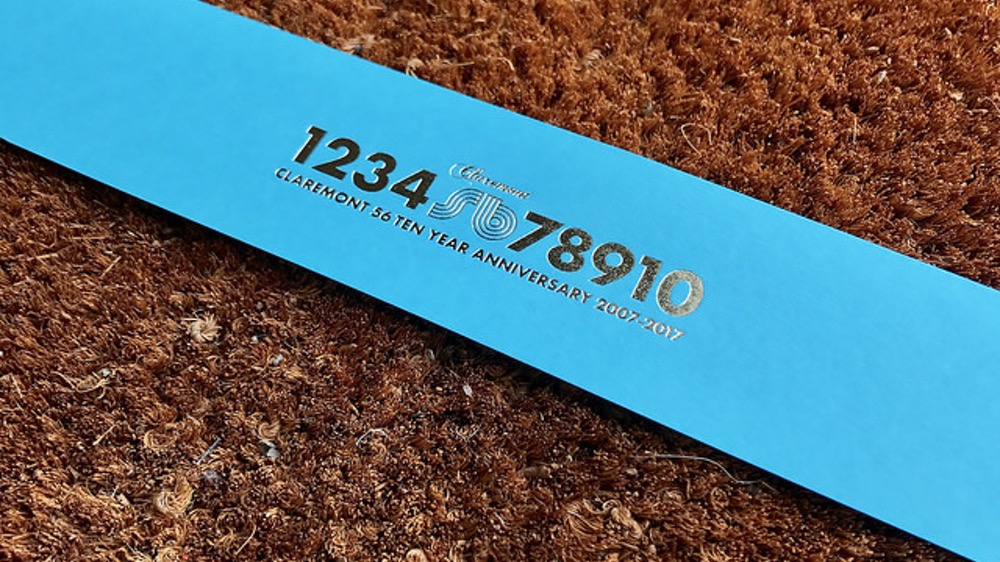Label Love #74: Claremont 56

“Initially I set up the label to release music that I was involved in, with some friends on remix duties, but amazingly, demos started appearing in my inbox from artists from all around the world. When Sebastian Gaiser (Icasol) sent me the track ‘Ongou’ in 2008, I knew I had to release it and it has just grown from there.”
Claremont 56 is the labour of love, a cottage record label founded and run by Paul ‘Mudd’ Murphy and this spring it reaches 10 years old. To mark this milestone anniversary they release a specially designed, hand-numbered box-set of unheard material across five weighty slabs of wax, including bespoke info sheet and artwork from artist Sickboy.

This attention to detail is something that was once lost under the digital revolution of the mid-noughties, but with the vinyl revival and collectors market seemingly booming you can be forgiven for forgetting that selling music is still an incredibly tricky business. So how, when launching a dying format record label in 2007, did Claremont 56 rise up amongst the digitally ruled music industry and thrive, not just survive?
An ethos of quality above quantity is at the heart of the operation that Paul began back in 2007. Digital music and CD was the choice format for consumers and becoming that for DJs as well. Music piracy was at its peak. It was more accessible than it had ever been and dance music could be created by anyone with a computer and the right software.
”When I started, it was shortly after the good times had ended (when 6,000 12”s were sold per release) so I went into a declining market. In the long-run, I think that has benefited me, as I’ve always worked to a low sale model, doing pretty much everything myself to keep my overheads down.”
But with the increase in digital music’s availability, for the period when everyone seemed to be downloading it for free, and for those that weren’t who were still paying £0.99-£1.99 for a single, naturally the intrinsic value of music was fast fading away. Aside from the market changes, the physical product was now not so physical. The digital file discarded the need for liner notes, only including bare essentials metadata, the act of purchasing music was now, primarily, online. It was a combination that rendered music as a singular, mass-produced and sales-driven product.
”I wanted to be more in control of my music and the art and felt that if I released it myself, I could do anything I wanted, not just aim the music at the dance floors.”
To decide to start a vinyl-centric label at that time doesn’t make (business) sense, but Paul’s desire to do this wasn’t born from the prospect of striking it rich. His love of music, art and his youth come together on Claremont 56 for a project completely under his control, with release titles initially inspired from his time growing up in Bricket Wood, a small town in Hertfordshire, a connection to his childhood that inspires a lot of the early release titles on the label and reflects his deeply personal relationship with the project from the beginning.
“My first solo album, released by Rong in 2007 was called Claremont 56, named after my address while I was growing up, this then became the name of my label when I set it up in 2005. ’N7 Odyssey’ is named after the flat I lived in, in London until 2015. All the track titles from my first (and to date, my only) solo album ‘Claremont 56’, released on Rong, have titles associated with Bricket Wood and my fond memories of that time.”
Paul’s entrance into the music game was a mix of youthful ambition and chance. He met the Idjut Boys in ‘93/94, a fan of their music and U-Star label. The sound was different to what was out there and he appreciated the graffiti-drawn middles, which accompanied each 12”. After a chance meeting and becoming friends it was the Idjut Boys’ Phreek parties at London's The Cross club, that inspired another change in Paul’s perspective.
I’d become a bit tired of going out and hearing 10 DJs play short sets, all playing pretty much the same music. The Idjuts were doing it differently. They picked a quality DJ, such as Ricky Morrison, and let him play all night. It was such a breath of fresh air and after giving them a tape and being told by Conrad (Idjut Boys) ‘yeah, good mix, but you play the same music as me so I’m not going to book you’, we became good friends.”

Paul together with Steve (Kotey) put on their own parties, with the Idjut Boys headlining on occasion with a bond that would develop for the next few years. It wasn’t long before producing music came into play and with Conrad’s guidance Paul, Steve, and friend Tom (Lee) started making tracks in a bedroom studio.
“At the time, Tom was helping out at a local recording studio and taking care of bookings and introduced us to a brilliant keyboard player called Lawrence Ee and after a few nights in my bedroom studio, recording with him, we finished our first single under the name Akwaaba, called ‘Just Pilau’.
‘Just Pilau’ got a release on Discfunction, the Idjut Boys’ (now defunct) label. The record release process was something Paul had a natural interest in and after several years releasing music himself on various labels he took this knowledge a step further and started Claremont 56.
Initially, only releasing his own material, with some friends on remix duties, the decision to release other artists was due to the horde of demo’s he was receiving from producers from all around the world. This shift started a year after the label began with Icasol ‘Ongou’ (2008). A reputation for releasing music from producers around the world was growing, and Paul was very receptive to the music he was receiving, humbled by artists wanting to release on Claremont 56, and proud to be able to provide a platform to do so.
“I can clearly remember the first time I listened to the demo of Bambi Davidson’s genius album. It honestly gave me goose bumps. The fact that I get to help artists like them release such quality music is very satisfying.”
This consideration of the artist is at the core of Claremont 56 and can be attributed to Paul’s own career in design, his disillusionment with agency work and the quality above quantity ethos.
Post-college he found work in a London-based design agency but after time the limitations of this large company approach — designing to low budgets, cheap production — left Paul wanting more, though the job had some benefits; namely the ability to sort, re-box and send the Claremont 56 orders from the despatch office.
His ability to design and create the artwork for each release adds a unique perspective that not many label owners, even now, are able to pair with their music.
”I put a lot of time into designing the artwork and love that people appreciate this effort. I usually have quite a strong idea of where I want to take it from the outset. The next step is to work out whether I can afford to create what I’ve imagined. One of the highlights has been commissioning illustrator Mark Warrington to create album artwork for me. After that initial commission, I gave Mark free reign to use his imagination and he’s produced some beautiful pieces for me and his work has become a huge part of the look of the label.”
The 10-year anniversary box-set comes in three options, with slightly different cover treatments and contents at different prices. Graffiti artist, Sickboy, is the artist behind the cover illustration, who was introduced to Paul by Mark (Warrington) as they shared a studio together.
“I buy limited edition prints occasionally and love the different options you sometimes get when a run is released, so I wanted to do something similar for the box set. I decided to use Sickboy’s heart illustration, on the front of one of the box set editions. I’m a big fan of Keith Haring and this illustration and treatment reminded me of some of Haring’s work. I wanted to include something for the collectors, so that edition also includes a signed Sickboy print, as well as a pair of leather slipmats. Sickboy gave me free reign to work with his illustrations and was up for whatever I wanted to do, so it was a real pleasure working with him and his work.”

This collaborative approach within art also permeates the music and has done since the beginning for both the label and his on artistry as Mudd. Having drifted between various producing pairs and groups — Mudd & Pollard, Smith & Mudd, Bison, and Paqua — during his own career the anniversary box-set is rich with musical collaboration, music from friends, associates and excitingly from heroes, Ron Trent, Larry Heard and Holger Czukay.
The latter, of ‘80s German prog-rock/experimental band, CAN, fame offers an unreleased track from the 90s, titled ‘Music To Be Murdered By’, a track gifted to Paul for Claremont 56 reaching 10 years. The pair became friends after Paul’s initial desire and persistence to release an extended section of his favourite song by Holger, ‘Ode To Perfume’. He convinced Holger (and wife Ursa) to allow permission and in 2009 ‘Ode To Perfume/Fragrance’ came out on a limited 10”.
”We’ve become very good friends over the years and I do their gardening when I visit them at their home in a little village, just outside Cologne. He’s a fascinating man, with lots of wonderful stories.”
One of these stories will now include Bison, the super group formed by Paul, Ben Smith, Holger and his wife Ursa. A request by Paul and Ben for Holger to work on a track they’d made came good, which resulted in releasing ‘Way Ta L.A.’. Some years later and the pair visited Holger and his wife, where they recorded music at the legendary Innerspace Studios, where CAN wrote of their hits.
“Ben and I were pretty nervous about meeting such a legend. We got to the airport where he met us, still feeling pretty nervous. He looked at us, gave us a massive smile and then a big hug We carried on writing with him and Ursa, but hit a bit of a creative roadblock so I asked Conrad to get involved. He was the one who had introduced me to Holger’s music in the first place, namely ‘Ode to Perfume’, so for us to work together with Holger was a wonderful circle of life. His deeper versions of the originals finished off the album and my wife Emma designed the cover, based on an initial idea that Ursa had.”
With an ethos focused on quality from the very beginning and a desire to do things right, and building relationships with likeminded people that extended across the world, Paul and his Claremont 56 legacy mark 10-years with integrity and style.






















